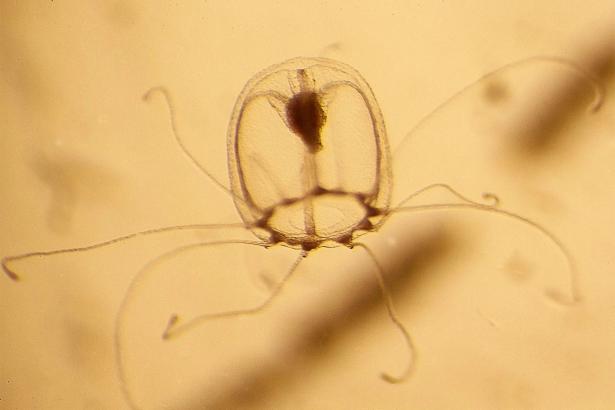A juvenile medusa-stage specimen of the Turritopsis dohrnii jellyfish.,Maria Pascual-Torner
Fleets of tiny translucent umbrellas, each about the size of a lentil, waft through the waters of the Mediterranean Sea. These miniature jellyfish, known as Turritopsis dohrnii, wave and grasp with their pale tentacles, bringing plankton to their mouths like many other jellyfish species adrift in the glowing water.
But they have a secret that sets them apart from the average sea creature: When their bodies are damaged, the mature adults, known as medusas, can turn back the clock and transform back into their youthful selves. They shed their limbs, become a drifting blob and morph into polyps, twiggy growths that attach to rocks or plants. Gradually, the medusa buds off the polyp once again, rejuvenated. While a predator or an injury can kill T. dohrnii, old age does not. They are, effectively, immortal.
Now, in a paper published Monday in The Proceedings of the National Academy of Sciences , scientists have taken a detailed look at the jellyfish’s genome, searching for the genes that control this remarkable process. By examining the genes active at different phases of the life cycle, the researchers got a glimpse of the delicate orchestration of the jellyfish’s rejuvenation.
Gathering enough T. dohrnii to study their genomes can be difficult. Only one scientist, Shin Kubota at Kyoto University in Japan, has successfully maintained a colony in the lab over the long term. (He has also written and performed songs inspired by his tiny subjects.)
When it comes to living in an aquarium, “they are very picky,” said Maria Pascual-Torner, a scientist at Universidad de Oviedo in Spain who studies the jellyfish. “And they are very, very small, which also makes them difficult to identify and sample in the field.”
To get enough material for the new paper, Dr. Pascual-Torner and a colleague drove a specially equipped camper van to a coast in Italy and went diving to gather wild jellyfish. They then rushed them back to the lab.
When they and their colleagues sequenced the creatures’ genomes, the researchers noticed that the jellyfish had extra copies of certain genes, a sign that these might be important for the creatures’ survival. The researchers found many of the duplicated genes among them, including some that protect and repair the jellyfish’s DNA, as DNA is often eroded with age in animals.
A Turritopsis dohrnii polyp. Credit...Maria Pascual-Torner
To trigger rejuvenation, the researchers put the jellyfish under stress by letting them go hungry, among other regimens. As the medusas shrank into little balls, sprouted polyps and began remaking their adult bodies, the scientists took snapshots of what genes they were using in each phase of their development. They took some jellyfish in each phase, froze them and turned them to mush to extract their mRNA, giving a record of which genes were actively being used to make proteins.
As the jellyfish transformed, the scientists were interested to see a marked change in the use of genes linked to DNA storage. In adults, these genes were active or expressed at a high level — that is, they were being used frequently to make proteins. But as the animals began their descent back into polyps, the genes became quieter, with their proteins reaching their lowest levels in the floating ball form.
Genes related to pluripotency, or a cell’s ability to grow into a variety of fully developed forms, did the opposite. They were quiet in the adult form but leaped into action as a jellyfish broke its body down and started to build it back up. The pluripotency genes then returned to dormancy when the process was complete.
What this suggests, Dr. Pascual-Torner said, is that DNA that’s normally in storage is brought out during the transformation, and genes that coax cells to reset go into overdrive.
The paper’s findings corroborate what her group of researchers saw in a similar study last year , said Maria Miglietta, a marine biology professor at Texas A&M University at Galveston who also studies T. dohrnii. Her team saw that genes related to DNA repair and protection were involved in the jellyfish’s rejuvenation.
Both sets of research suggest when and how much the jellyfish’s genes are expressed matters just as much as the genes themselves in giving an old body new life. In other words, there is no gene for immortality, but there is certainly a procedure for it.
The researchers hope to understand more about this dance of unfurling DNA. If the storage proteins were tweaked to stay active, would the jellyfish be able to start over? Or would they be trapped, like the rest of us, able only to move forward in time?
Still, we are unlikely to be able to make use of the T. dohrnii’s process.
“Our goal is not to find the formula of human immortality,” Dr. Pascual-Torner said. “Jellyfish are very different from humans. It’s not just about one gene or complex. It’s about the whole mechanism we found that works together.”
Whether any of these processes in T. dohrnii’s body have a parallel in the human body is an open question. But for the foreseeable future, this fountain of youth is just for jellyfish.
Veronique Greenwood is a science writer and essayist. Her work has appeared in The New York Times Magazine, Smithsonian, Discover, Aeon, Quanta and other publications.
A version of this article appears in print on Sept. 13, 2022, Section D, Page 2 of the New York edition of the New York Times with the headline: Rejuvenation Process: This Jellyfish Can Live Forever. Its Genes May Tell Us How.. Subscribe


Spread the word